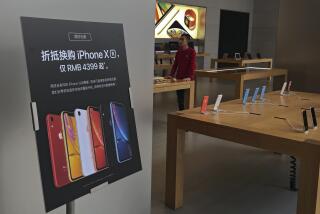Were Apple’s iPad sales really as bad as they looked?
Apple investors were rejoicing this week after the company reported first-quarter earnings that were far better than expected, thanks to strong iPhone sales. Throw in an additional $30 billion that the company plans to spend on stock buybacks and dividends, and shareholders ended the day with big grins.
Perhaps the only blemish on an otherwise big day for Apple were sales of iPads.
Analysts were expecting iPad sales to fall to 19.38 million from 19.48 million in the same quarter a year ago. Instead, the company said it sold only 16.35 million units.
VIDEO: Unboxing the Tonino Lamborghini Antares smartphone
That dropoff was a shocker. And during its earnings call on Wednesday, Apple chief executive Tim Cook jumped right in with an explanation.
Cook said Apple should have done a better job highlighting for analysts how inventory issues might lead to what seemed like an usually steep drop in iPad sales.
“IPad sales came in at the high end of our expectations, but we realized they were below analyst estimates, and I would like to proactively address, why we think there was a difference,” Cook said on the call.
He explained that a year ago, the company had a hard time meeting iPad demand during the holiday quarter. As a result, a large number of iPad sales spilled into the March 2013 quarter, inflating those numbers.
The thing to keep in mind about Apple’s sales figure of 16.35 million iPads is that the company counts a product as sold when it sells it to a partner, like Best Buy, or directly to a consumer.
Apple noted on its earnings call that if you look at “sell through,” that is the number of iPads sold by partners like Best Buy to consumers or directly to consumers from Apple, then the company moved 17.5 million iPads during the most recent quarter, down from 18 million for the same quarter a year ago.
“The year-over-year sell-through decline was only 3% compared to the sell-in decline of 16%,” said Apple Chief Financial Officer Luca Maestri.
So it may be not as bad as it first looks. But still, down is down. Especially compared with a 16.8% increase in iPhone sales. (Apple did not disclose sell-through figures for iPhones.)
“It’s alarming,” said Colin Gillis, an analyst at BGC Partners. “Even in the best case, it was down 3%.”
Here’s another way to look at iPad sales. In the first half of Apple’s 2014 fiscal year (which ends in September), the company has reported iPad sales of 42.35 million units. For the same period a year earlier, the company reported sales of 42.08. That’s a year-over-year increase of just 0.6%
(Again, that’s official sales to channel partners and direct to customers, not “sell through” to customers.)
“Apple has proved many of the iPhone critics wrong by showing they could exceed smartphone revenue expectations,” said Patrick Moorhead, of Moor Insights & Strategy. “They do need to figure out a different plan for tablets given they are losing share quarter by quarter to lower cost Android tablets.”
So what is the plan? During the conference call, one analyst put that question to Cook.
“I understand that the iPad is not as weak as it appears on a sell-through basis, but still it’s relatively flat over the last year in terms of sell-through,” asked Steve Milunovich of UBS Securities, on the conference call. “What are your thoughts in terms of why that is, and can that accelerate with Office on the iPad going forward?”
Cook, clearly prepared for such questions, said it was important to not lose sight of the iPad’s phenomenal success.
“In just four years after we launched the very first iPad, we’ve sold over 210 million, which is more than we or I think anyone thought was possible at that period of time,” Cook said. “And it’s interesting to note that that’s almost twice as many iPhones that we’ve sold in a comparable period of time, and over seven times as many iPods as we’ve sold in the period of time. So, I think it’s important to kind of to put that in perspective. We’ve come a long way very, very quickly.”
Cook also said in two critical markets, education and business, iPads have had early success but have lots of room to grow within organizations and institutions that have just begun using them on a trial basis.
“And so once again, just like in education in a way, what we have to do in enterprise is focus on penetration,” Cook said. “It has to be deeper and broader. But in terms of having people begin the process, beginning writing apps, we’re doing a pretty good job of that.”
Of course, the other part of the strategy is to continue to update the existing line of iPads and iPad minis with new features and faster processors.
All this has Cook feeling bullish about the outlook for the iPad.
“When I back up from all of these, I feel great,” he said. “That doesn’t mean that every quarter, every 90 days is going to be a number that everybody is thrilled with. But what it means to me is that the trend over the arc of time is that things look very, very good, that iPad has a great future.”
Cook added:
“We continue to believe that the tablet market will surpass the PC market in size within the next few years and we believe that Apple will be a major beneficiary of this trend.”
ALSO:
Next Apple TV will come with Siri voice assistant, report says
Apple shares surge as second-quarter revenue tops forecasts
Facebook blows past estimates, reports big gains in revenue and profit






